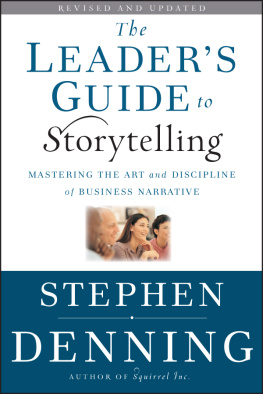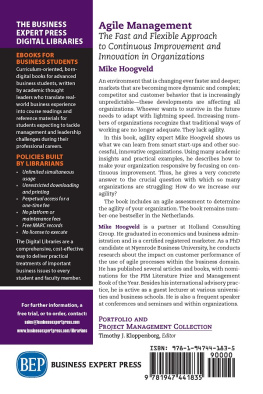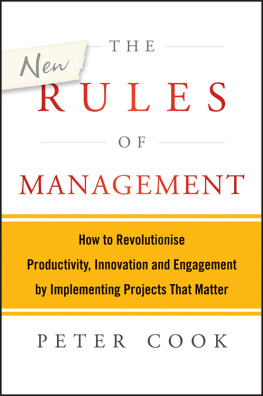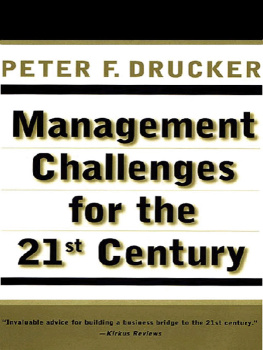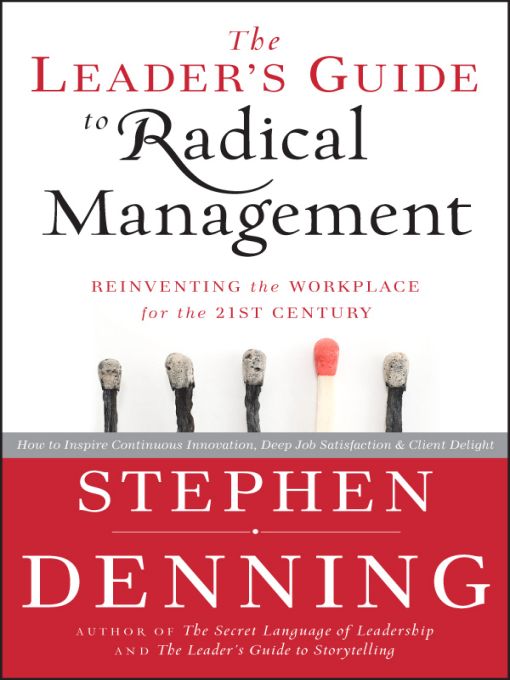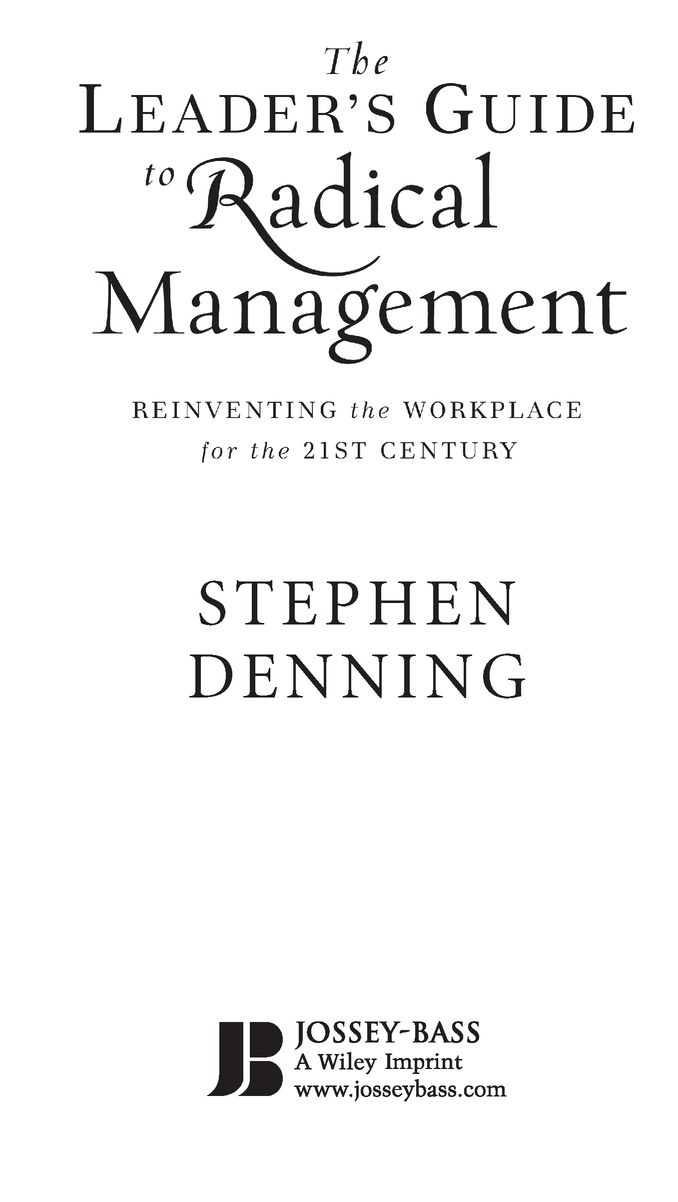Table of Contents
PREFACE
Remarkably, the return on assets for U.S. firms has steadily fallen to almost one quarter of 1965 levels ... very few [workers] (20 percent) are passionate about their jobs... executive turnover is increasing. Consumers are becoming less loyal to brands... the rate at which big companies lose their leadership positions is increasing.
Deloitte Center for the Edge
Total Attorneys is a rapidly growing Chicago-based company that provides services and software to small law firms. As a start-up in 2002, it was highly energized: work was done on the fly, new products were developed, new markets opened, and new customers were identified. But as the firm grew, so did bureaucracy. Departments were formed, processes and structures were put in place, work slowed down, and the staff morale deteriorated. In some cases, Total Attorneys moved so slowly that by the time its software was completed, the client wanted something different. By 2008, with around 160 employees, Total Attorneys was still making money, but it had gone from being an exciting place to work to a bureaucratic logjam.
Up to this point, Total Attorneys was a depressingly familiar story. But Total Attorneys CEO, Ed Scanlan, began asking himself: Why were we able to get more done in forty-five days with three guys than I had just accomplished in the last six months with several departments? Why are our tires stuck in the mud?
So Scanlan decided to change the story and recapture some of the start-up energy and excitement. He replaced departmental silos with small cross-functional teams that themselves decided how to do the work and even how much work to do. The teams began working in cycles, implementing a prioritized series of tasks that reflected what clients wanted to see developed. At the end of each cycle, the work was demonstrated to clients, and their feedback was incorporated in the next cycle. In this way, the work was always focused on tasks of high priority to clients.
Scanlan started the approach with the software developers, but it was so successful there that he soon extended it to the call centers. For instance, the eighty-five call center employees were divided into fifteen teams and colocated on the same floor as the software developers to enhance direct communication.
More recently, the approach has spread spontaneously to sales, marketing, accounting and the general counsels office. Now the whole firm is buzzing with energy and excitement and laughter again.
This way of managing appeals particularly to the new generation, says Scanlan. They want autonomy. They want ownership. They want purpose. It makes sense to them. But it also resonates with older workers.
Many firms are now discovering what Total Attorneys discovered: that a revolutionary way of organizing and managing work is emerging that can generate continuous innovation, deep job satisfaction, and client delight. It is very different from the practices of traditional management: hierarchy, command and control, tightly planned work, competition through economies of scale and cost reduction, and impersonal communications.
Traditional management practices, which continue to be taught in business schools and described in management textbooks, worked well enough for much of the twentieth century but are a poor fit for todays economic context.
The signs of the misfit are widespread. The rate of return on assets keeps on its decades-long decline. Innovation continues to falter. Workers are disgruntled. Customers are frustrated. Brands are unraveling. Reorganizations, downsizings, and outsourcings proliferate. Executive turnover is accelerating. Institutional life expectancies are less than two decades. In the past twenty-five years, start-ups created 40 million jobs in the United States, while established firms created almost none.
Early in 2008, I set out to understand the source of these problems and to discover what could be done about them. This book tells the story of that journey.
There must be workplaces, I thought, where work is highly productive, new ideas are embraced, and jobs are deeply satisfying. Could the conditions that had enabled that to happen be identified? Could those conditions be reverse-engineered? Is it possible to create an environment that was congenial to ideas that are vibrant, exciting, or different, in a sustained way, not just in isolated cases?
I began by asking people if they knew about any such workplaces. My expectation was that finding them would be difficultlike searching for a needle in a haystack. Few people would know about them, I thought, let alone have personal experience of them.
My first surprise was that I had no difficulty at all in finding them. In fact, almost everyone I talked to could tell me about an experience that they had, although typically it wasnt in their current workplace.
The second surprise came when I noticed that an unusually high proportion of these extraordinary experiences had been in software development. Initially I didnt pay this any attention. After all, these were geeks, and they talked with a strange vocabulary. What could I possibly learn about management from people who had, I imagined, gone into computing because they preferred machines to people?
My third surprise was what was going on in these companies. When I checked it out, I discovered a way of managing that was much more productive than traditional management and where the people doing the work were having serious fun.
The fourth surprise was that it wasnt limited to software development. Once this different way of managing got under way in one part of the company, it tended to spread to other parts of the company, even the entire firm. It was also widespread in some parts of auto manufacture and in successful start-ups. In fact, once I understood the principles, I started to see signs of it in many different sectors.
The final big surprise was that when I joined the dots and fully understood the elements, I realized that what I had stumbled on was more than a management technique. The idea was larger, with far-reaching economic, social, and ethical implications.
Overall, this was very different from the way most companies are currently run. As Mikkel Harbo, director of business development and operations at the Danish company Systematic Software told me, Once you introduce this, it affects everything in the organizationthe way you plan, the way you manage, the way you work. Everything is different. It changes the game fundamentally.
It is for this reason that I call it radical management. It goes to the root of what makes things happen in the world. The workplaces that it creates are drastically different from traditional management. It implies fundamental shifts in how we think, speak, and act at work.
In this book, I am inviting you to take the journey that I have taken and learn what I have learned. It will mean spending time to think about what we are doing in organizations today and why. It will entail considering what kinds of organizations we want to create, as well as imagining why and how they could be very different from most organizations todayproviding work that is much more productive and much more satisfying.
This book doesnt offer a quick fix, because the nature and scale of the issues that we are dealing with in todays workplaces are not susceptible to a quick fix.


